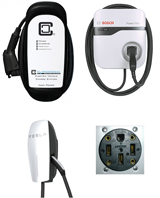All About EVSEs (Electric Vehicle Supply Equipment)

An Electric Vehicle Supply Equipment (EVSE) is a box that supplies electricity to an Electric Vehicle (EV). The EVSE does several things:
- First, it has a cord and a plug/handle for connecting to the EV.
- Second, it provides safety features. The EVSE handle will not energize with the high power needed to charge the car unless its low power control pins detect that it is firmly plugged into a car.
- Third, the EVSE tells the car how much power it can give the car. That way the car won't try to draw more power than the electrical circuit the EVSE is connected to can handle.
As a new EV owner, you typically need to buy and install your own EVSE in your garage or outdoors where you park your car (EVSEs are typically outdoor rated).
J1772 to Tesla/NACS Transition

As of mid-2023 until 2025, we are in a transition period in North America as non-Tesla EVs transition from the J1772 plug/handle to the Tesla plug/handle, now called NACS (North American Charging Standard). To ease this transition, Tesla makes an EVSE that supports both plugs in a very elegant way. If you pull the handle by itself, you get a Tesla (NACS) plug, if you press on a thumb button as you pull it out, you get a J1772 plug.
Because of this transition, I'd recommend only buying either of these Tesla Wall Chargers for any new EVSE installation:
- Tesla Universal Wall Connector if you have a non-Tesla EV.
- Tesla Wall Connector if you only have a Tesla.
Tesla Wall Connectors can be programmed to share loads (you can set a maximum current draw for the combination of up to six Wall Connectors), have WiFi features, and are a 3rd generation design, so they are very well made. They are also reasonably priced.
Plug In EVSEs
If you want to use an existing or new electrical receptacle to plug in an EVSE, there are plenty of J1772 plug in EVSEs for non-Teslas available at Home Depot, Lowes and Amazon among others. Look for one that is UL approved. For Teslas, I'd recommend the Tesla Mobile Connector with the appropriate receptacle adapter. Non Telsa EVs can also use the Tesla Mobile Connector with the appropriate adapter.
While you can use a regular 120V household receptacle to charge an EV, I generally don't recommend it and instead recommend that people install a 240V dedicated circuit for EV charging. Click here to learn more about charging on 120V.
Installing EVSEs
Most people opt to hire an electrician to install an EVSE. The electrician will install the appropriate two pole breaker (usually a 40A or 50A breaker for 32A charging, or 60A breaker for 48A charging), route the appropriate sized wire and/or conduit, and connect it to where you want to install your EVSE. To install an EVSE yourself, check out this DIY EVSE Installation page.
Using EVSEs
Once the EVSE is installed, using it is very simple. Just plug it into your EV. There is no need for on/off switches or any other control to charge your car.
Depending on where you live, your power company may give you better electricity rates in the middle of the night. Check to see if they do, and if so, usually your EV will have settings to start charging at midnight, for example, rather than when you plug in when you get home.
Overloaded Panel
It isn't unusual for older homes and condos to have smaller electrical panels where it can be challenging to provision a large electrical circuit. Check out this page which has a lot of information of how to deal with overloaded panels.
